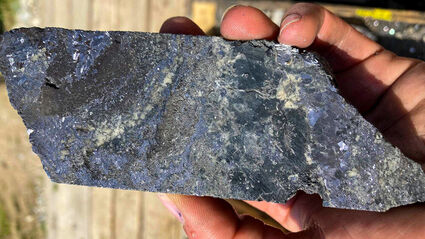Massive sulfides in Waterpump Creek core
Western Alaska encouraged by what it sees; assays pending North of 60 Mining News – July 8, 2022
Last updated 7/21/2022 at 2:48pm

Western Alaska Minerals Corp.
Zinc and silver-enriched lead massive sulfide mineralization encountered in hole WPC22-08 drilled at Waterpump Creek.
Western Alaska Minerals Corp. July 5 reported encouraging massive sulfide intercepts in four of the holes drilled so far this year at the high-grade Waterpump Creek carbonate replacement silver-zinc-lead target on its Illinois Creek project in western Alaska.
Based on previous exploration carried out by Anaconda Minerals Company and Novagold Resources Inc., Waterpump Creek hosts 166,000 tons of historical resource averaging 295 grams per metric ton silver, 16.1% lead, and 5.5% zinc.
Highlights from nine holes drilled by Western Alaska at Waterpump last year include:
• 16.7 meters (15.7 meters true-thickness) averaging 256 grams per metric ton silver, 0.7% zinc, and 6.4% lead from a depth of 23.2 meters in hole WPC21-02.
• 1.5 meters (1.4 meters true-thickness) averaging 1,337 g/t silver from a depth of 50.9 meters; and 9.7 meters (9.1 meters true-thickness) averaging 89 g/t silver, 6.3% zinc, and 7.7% lead from a depth of 63.1 meters in hole WPC21-03.
• 11.9 meters (11.2 meters true-thickness) averaging 149 g/t silver and 2% zinc from a depth of 35.6 meters in hole WPC21-05.
• 10.5 meters (9.1 meters true-thickness) averaging 522 g/t silver, 22.5% zinc, and 14.5% lead from a depth of 109.4 meters in hole WPC21-09.
The company reports that four of the 13 holes drilled so far this year – WPC22-07, WPC22-08, WPC22-011 and WPC22-13 – have cut significant massive sulfide. These intercepts include massive sphalerite (zinc mineral) and argentiferous galena (silver-rich lead mineral) in a matrix of secondary dolomite, which is similar to the high-grade intercepts cut during the 2021 drilling at Waterpump Creek.
Hole WPC22-07 cut 4.5- and 14-meter-thick zones of massive sulfide about eight meters apart. Likewise, hole WPC22-11 cut 11.5- and 3.6-meter zones of massive sulfide separated by 2.1 meters of gossan.
While Western Alaska is encouraged by the drill core observations, the company cautions that assays are pending from all the holes, and the significance of the massive sulfide zones will not be known until results are back from the lab.
The initial focus of drilling at Waterpump Creek has focused on expanding the mineralized footprint and to develop basic ore controls and trends of the high-grade mineralization encountered last year.
Initial drilling down-dip of WPC21-09 shows a major rollover of the dolomite stratigraphy into the high angle to vertical north-trending Waterpump Creek structure. Initial holes drilled in 2022 were east of the structure and did not encounter mineralization. Subsequent drilling along strike to the south of the WPC21-09 intercept shows mineralization occurs as massive carbonate replacement mineralization within the footwall dolomite immediately west of the Waterpump Creek structure.
Due to the sharp boundary between mineralized massive sulfide and unmineralized dolomite, which is common with carbonate replacement deposits, drill spacing has been tightened to a 25-meter grid in order to effectively target the resource expansion to the south. Current drilling is just over 100 meters south of the WPC21-09 and progressing south on 25-meter profiles.
In addition to drilling, a major system-wide CSAMT (controlled-source audio-magnetotellurics) geophysics program has just been completed over the roughly five miles (eight kilometers) between the Illinois Creek oxide gold-silver mineralization, Last Hurrah high-grade gold and Waterpump Creek target area. Inversion modeling of the CSAMT sections is ongoing.

Western Alaska Minerals Corp.
Iron-rich zinc mineralization with infilling intergrown dolomite crystals that are cut by veinlets of silver-enriched galena encountered in hole WPC22-07 drilled at Waterpump Creek.
Preliminary results, however, show a complex interplay of stacked thrusts and high-angle and possibly post-mineral faulting. The Waterpump Creek structure, which appears to be the major ore control at Waterpump Creek, is apparent over at least 3.7 miles (six kilometers) of strike within the CSAMT sections south from Waterpump Creek through Last Hurrah to just east of a major manto/gossan East Illinois Creek manto/gossan (flat-lying, bedded deposit/rust-colored oxide mineralization).
In addition to the Waterpump Creek structural zone, numerous other targets are apparent in the initial inversions. More definitive targeting and targeting discussion will be forthcoming as the data is completely processed.












Reader Comments(0)